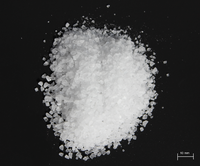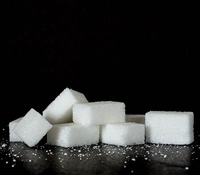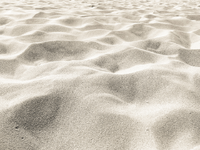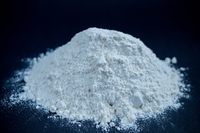|
|
| Line 1: |
Line 1: |
| − | ==Key Stage 3== | + | ==Key Stage 2== |
| | ===Meaning=== | | ===Meaning=== |
| − | [[Sugar]] is a simple [[carbohydrate]] found in food and is a source of energy for [[respiration]]. | + | [[Solubility]] is how easy it is to [[dissolve]] a [[solid]] in a [[liquid]]. |
| | | | |
| − | ===About Sugar=== | + | ===About Solubility=== |
| − | ====Sugar Molecules====
| + | : If it is very easy to dissolve something then it is called '''soluble'''. |
| − | : '''Sugar''' [[molecule]]s are referred to as 'simple [[molecule]]s' which can be quickly [[Absorb (Biology)|absorbed]] into the body to provide [[energy]] by [[respiration]]. | + | : If it is very difficult to dissolve something it is called '''insoluble'''. |
| − | : You should know: | |
| − | *Glucose - A sugar found in syrup and sweets.
| |
| − | *Fructose - A sugar found in fruits.
| |
| − | *Sucrose - Found in white sugar which is made of one glucose molecule and one fructose molecule bonded together.
| |
| | | | |
| | + | ===Examples=== |
| | {| class="wikitable" | | {| class="wikitable" |
| | + | |+ Soluble Materials |
| | |- | | |- |
| − | |[[File:SugarMolecules.png|center|400px]] | + | | style="height:20px; width:200px; text-align:center;" |Salt |
| | + | | style="height:20px; width:200px; text-align:center;" |Sugar |
| | |- | | |- |
| − | | style="height:20px; width:400px; text-align:center;" |There are many different sugar molecules. These are just three examples. | + | |[[File:Salt.png|center|200px]] |
| | + | |[[File:Sugar.png|center|200px]] |
| | |} | | |} |
| | | | |
| − | ====Sugar in foods====
| |
| | {| class="wikitable" | | {| class="wikitable" |
| − | |[[File:Fruit.png|center|200px]] | + | |+ Insoluble Materials |
| − | |[[File:Yoghurt.png|center|200px]]
| |
| − | |[[File:Sweets.png|center|200px]]
| |
| − | |[[File:EnergyDrinks.png|center|200px]]
| |
| | |- | | |- |
| − | | style="height:20px; width:200px; text-align:center;" |Fruit has lots of [[sugar]] but is healthy because the [[sugar]]s are released slowly during [[digestion]] and it also has [[vitamins]] and [[fibre]] inside. | + | | style="height:20px; width:200px; text-align:center;" |Sand |
| − | | style="height:20px; width:200px; text-align:center;" |Yoghurt has a lot of [[sugar]] but there are also some health parts like a [[mineral]] called [[Calcium]]. | + | | style="height:20px; width:200px; text-align:center;" |Flour |
| − | | style="height:20px; width:200px; text-align:center;" |Sweets are full of [[sugar]] with nothing healthy in them.
| |
| − | | style="height:20px; width:200px; text-align:center;" |Energy drinks have nothing healthy in them and are packed with [[sugar]].
| |
| − | |}
| |
| − | | |
| − | ====Testing For Sugars====
| |
| − | : [[Glucose]] and Fructose can be detected with the [[Benedict's Test]].
| |
| − | : [[Sucrose]] cannot be detected with the [[Benedict's Test]] unless you first react it with [[dilute]] [[Hydrochloric Acid]].
| |
| − | =====Method=====
| |
| − | : 1. A sample of food is [[dissolve]]d in [[water]].
| |
| − | : 2. The solution is added to blue [[Benedict's Test|Benedict's]] [[solution]] in a [[Boiling Tube|boiling tube]].
| |
| − | : 3. The [[solution]] is kept at 90°C for up to 10 minutes.
| |
| − | : 4. A colour change indicates the presence of [[glucose]] or [[fructose]]. If they are present the solution will eventually turn brick red or brown.
| |
| − | | |
| − | {| class="wikitable"
| |
| | |- | | |- |
| − | |[[File:BenedictsTest.png|center|600px]] | + | |[[File:Sand.png|center|200px]] |
| − | |- | + | |[[File:Flour.png|center|200px]] |
| − | | style="height:20px; width:600px; text-align:center;" |When sugar is present the Benedict's solution turns from blue through several colours until it becomes brick red or brown. | |
| − | If this was done with sucrose the Benedict's solution would stay blue.
| |
| | |} | | |} |
| | | | |
| − | ==Key Stage 4== | + | ==Key Stage 3== |
| | ===Meaning=== | | ===Meaning=== |
| − | '''Sugar''' is a term used to refer to several [[monosaccharide]]s and [[disaccharide]]s.
| + | [[Solubility]] is the maximum mass of [[solute]] that can [[dissolve]] in a given [[mass]] of [[water]]. |
| − | | |
| − | ===About Sugar===
| |
| − | : '''Sugar''' [[molecule]]s can join together in [[Condensation Polymerisation|condensation polymerisation]] [[Chemical Reaction|reactions]] to form [[polysaccharide]]s.
| |
| − | : The [[monosaccharide]] '''sugars''' you should know:
| |
| − | :*[[Glucose]] - A '''sugar''' found in syrup and sweets.
| |
| − | :*[[Fructose]] - A '''sugar''' found in fruits.
| |
| − | :*[[Galactose]] - A '''sugar''' found in milk.
| |
| − | : The [[disaccharide]]s you may know, but do not have to remember:
| |
| − | :*[[Sucrose]] - One [[glucose]] and one [[fructose]] [[molecule]] bonded together.
| |
| − | :*[[Lactose]] - One [[glucose]] and one [[galactose]] [[molecule]] bonded together.
| |
| − | :*[[Maltose]] - Two [[glucose]] [[molecule]]s bonded together.
| |
| − | {| class="wikitable"
| |
| − | |-
| |
| − | |[[File:SugarMolecules.png|center|400px]]
| |
| − | |-
| |
| − | | style="height:20px; width:400px; text-align:center;" |There are many different sugar molecules. These are just three examples.
| |
| − | |}
| |
| − | ====Testing For Sugars====
| |
| − | : [[Glucose]] and Fructose can be detected with the [[Benedict's Test]].
| |
| − | : [[Sucrose]] cannot be detected with the [[Benedict's Test]] unless you first react it with [[dilute]] [[Hydrochloric Acid]].
| |
| − | =====Method=====
| |
| − | : 1. A sample of food is [[dissolve]]d in [[water]].
| |
| − | : 2. The solution is added to blue [[Benedict's Test|Benedict's]] [[solution]] in a [[Boiling Tube|boiling tube]].
| |
| − | : 3. The [[solution]] is kept at 90°C for up to 10 minutes.
| |
| − | : 4. A colour change indicates the presence of [[glucose]] or [[fructose]]. If they are present the solution will eventually turn brick red or brown.
| |
| | | | |
| − | {| class="wikitable"
| + | ===About Solubility=== |
| − | |-
| + | : If a large mass of [[solute]] is able to [[dissolve]] in a given [[mass]] of [[water]] it is referred to as '''soluble'''. |
| − | |[[File:BenedictsTest.png|center|600px]]
| + | : If only a small [[mass]] of [[solute]] is able to [[dissolve]] in a given [[mass]] of [[water]] it is referred to as '''insoluble'''. |
| − | |-
| |
| − | | style="height:20px; width:600px; text-align:center;" |When sugar is present the Benedict's solution turns from blue through several colours until it becomes brick red or brown.
| |
| − | If this was done with sucrose the Benedict's solution would stay blue. | |
| − | |}
| |
| | | | |
| | ===References=== | | ===References=== |
| − | ====AQA====
| |
| − |
| |
| − | :[https://www.amazon.co.uk/gp/product/0008158754/ref=as_li_tl?ie=UTF8&camp=1634&creative=6738&creativeASIN=0008158754&linkCode=as2&tag=nrjc-21&linkId=27ad53b0283feeff7fc5ae04a9e205f536 ''Sugar, pages 58, 76-7, 88-9, GCSE Biology; Student Book, Collins, AQA '']
| |
| − | :[https://www.amazon.co.uk/gp/product/1782945598/ref=as_li_tl?ie=UTF8&camp=1634&creative=6738&creativeASIN=1782945598&linkCode=as2&tag=nrjc-21&linkId=ad276ad49df77ab4b40ab4fd0fe10328 ''Sugars (test for), page 28, GCSE Combined Science; The Revision Guide, CGP, AQA '']
| |
| − | :[https://www.amazon.co.uk/gp/product/1782945563/ref=as_li_tl?ie=UTF8&camp=1634&creative=6738&creativeASIN=1782945563&linkCode=as2&tag=nrjc-21&linkId=9a1d023a374038e6072f33c4f3cf808b ''Sugars (test for), page 32, GCSE Biology; The Revision Guide, CGP, AQA '']
| |
| − | :[https://www.amazon.co.uk/gp/product/0198359381/ref=as_li_tl?ie=UTF8&camp=1634&creative=6738&creativeASIN=0198359381&linkCode=as2&tag=nrjc-21&linkId=47c8d1ae58d8b3a5e2094cd447154558 ''Sugars, pages 172-173, GCSE Chemistry; Third Edition, Oxford University Press, AQA '']
| |
| − | :[https://www.amazon.co.uk/gp/product/0198359373/ref=as_li_tl?ie=UTF8&camp=1634&creative=6738&creativeASIN=0198359373&linkCode=as2&tag=nrjc-21&linkId=952a73bbb09d222ecc4b50d200679849 ''Sugars, pages 40, 64, GCSE Biology; Third Edition, Oxford University Press, AQA '']
| |
| − |
| |
| | ====Edexcel==== | | ====Edexcel==== |
| | | | |
| − | :[https://www.amazon.co.uk/gp/product/1782945725/ref=as_li_tl?ie=UTF8&camp=1634&creative=6738&creativeASIN=1782945725&linkCode=as2&tag=nrjc-21&linkId=694be7494de75af3349537d34e13f7f0 ''Sugars, page 100, GCSE Chemistry; The Revision Guide, CGP, Edexcel '']
| + | :[https://www.amazon.co.uk/gp/product/1292120215/ref=as_li_tl?ie=UTF8&camp=1634&creative=6738&creativeASIN=1292120215&linkCode=as2&tag=nrjc-21&linkId=8f96ddb76196848bafdb124354e4cf77 ''Solubility, pages 68-69, GCSE Chemistry, Pearson, Edexcel ''] |
| − | :[https://www.amazon.co.uk/gp/product/1292120215/ref=as_li_tl?ie=UTF8&camp=1634&creative=6738&creativeASIN=1292120215&linkCode=as2&tag=nrjc-21&linkId=8f96ddb76196848bafdb124354e4cf77 ''Sugars, pages 176, 185, GCSE Chemistry, Pearson, Edexcel ''] | |
| | | | |
| | ====OCR==== | | ====OCR==== |
| − | :[https://www.amazon.co.uk/gp/product/1782945660/ref=as_li_tl?ie=UTF8&camp=1634&creative=6738&creativeASIN=1782945660&linkCode=as2&tag=nrjc-21&linkId=83aa4500ad7759e7f401a1c5ba5df758 ''Sugars, page 23, Gateway GCSE Biology; The Revision Guide, CGP, OCR '']
| + | :[https://www.amazon.co.uk/gp/product/0198359829/ref=as_li_tl?ie=UTF8&camp=1634&creative=6738&creativeASIN=0198359829&linkCode=as2&tag=nrjc-21&linkId=90e8d7b4f039d53035238fa0320fe00b ''Solubility, page 43, 116, 276, Gateway GCSE Chemistry, Oxford, OCR ''] |
| − | :[https://www.amazon.co.uk/gp/product/1782945695/ref=as_li_tl?ie=UTF8&camp=1634&creative=6738&creativeASIN=1782945695&linkCode=as2&tag=nrjc-21&linkId=ceafcc80bcad6b6754ee97a0c7ceea53 ''Sugars, pages 20, 40, Gateway GCSE Combined Science; The Revision Guide, CGP, OCR '']
| |
| − | :[https://www.amazon.co.uk/gp/product/0198359829/ref=as_li_tl?ie=UTF8&camp=1634&creative=6738&creativeASIN=0198359829&linkCode=as2&tag=nrjc-21&linkId=90e8d7b4f039d53035238fa0320fe00b ''Sugars, pages 204, 205, 245, Gateway GCSE Chemistry, Oxford, OCR ''] | |
| − | :[https://www.amazon.co.uk/gp/product/0198359810/ref=as_li_tl?ie=UTF8&camp=1634&creative=6738&creativeASIN=0198359810&linkCode=as2&tag=nrjc-21&linkId=d768d99f1a06f7c12fab40e5aef85a55 ''Sugars, pages 38, 47, Gateway GCSE Biology, Oxford, OCR '']
| |
| − | :[https://www.amazon.co.uk/gp/product/1782945660/ref=as_li_tl?ie=UTF8&camp=1634&creative=6738&creativeASIN=1782945660&linkCode=as2&tag=nrjc-21&linkId=83aa4500ad7759e7f401a1c5ba5df758 ''Sugars; testing for, page 24, Gateway GCSE Biology; The Revision Guide, CGP, OCR '']
| |



